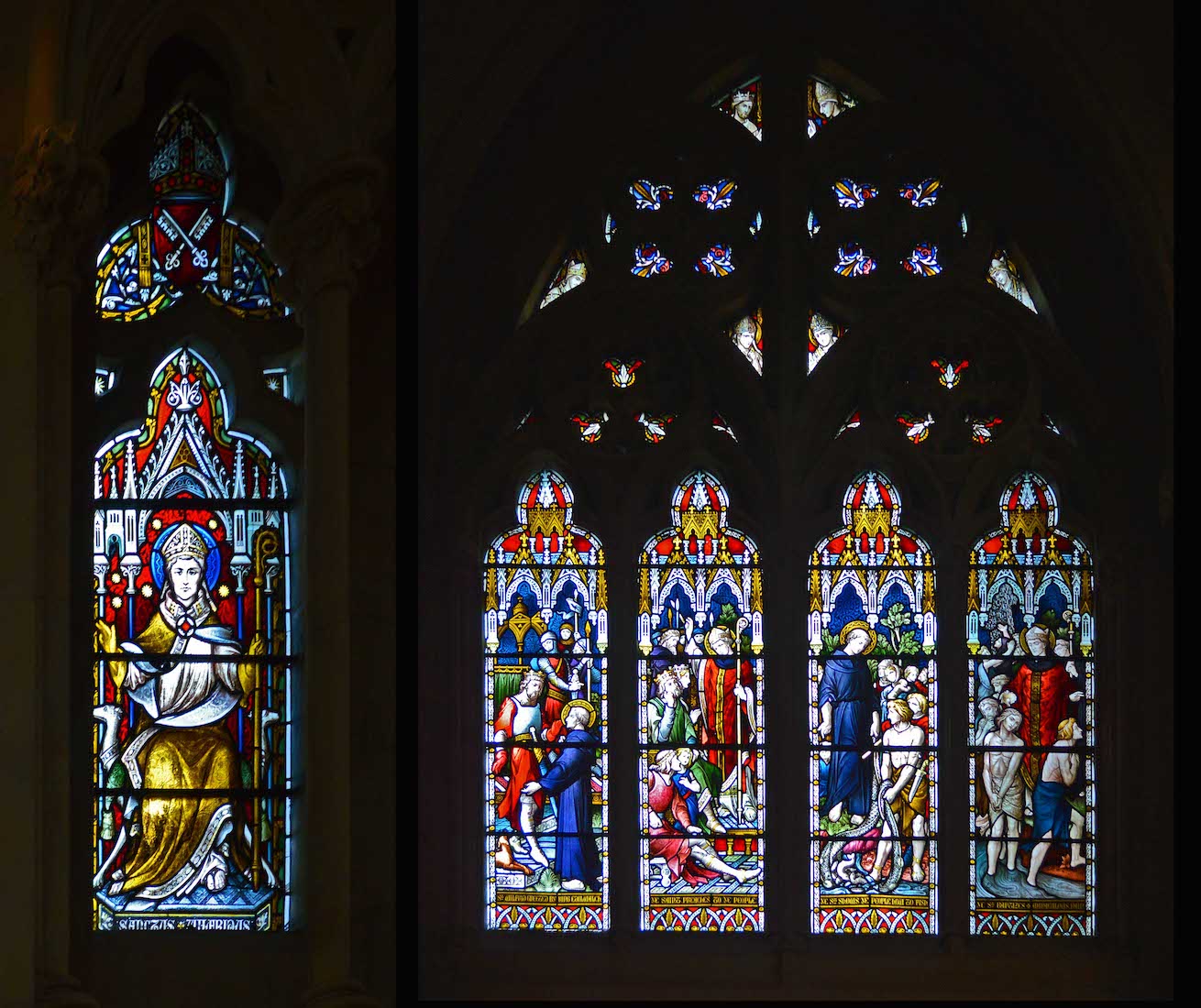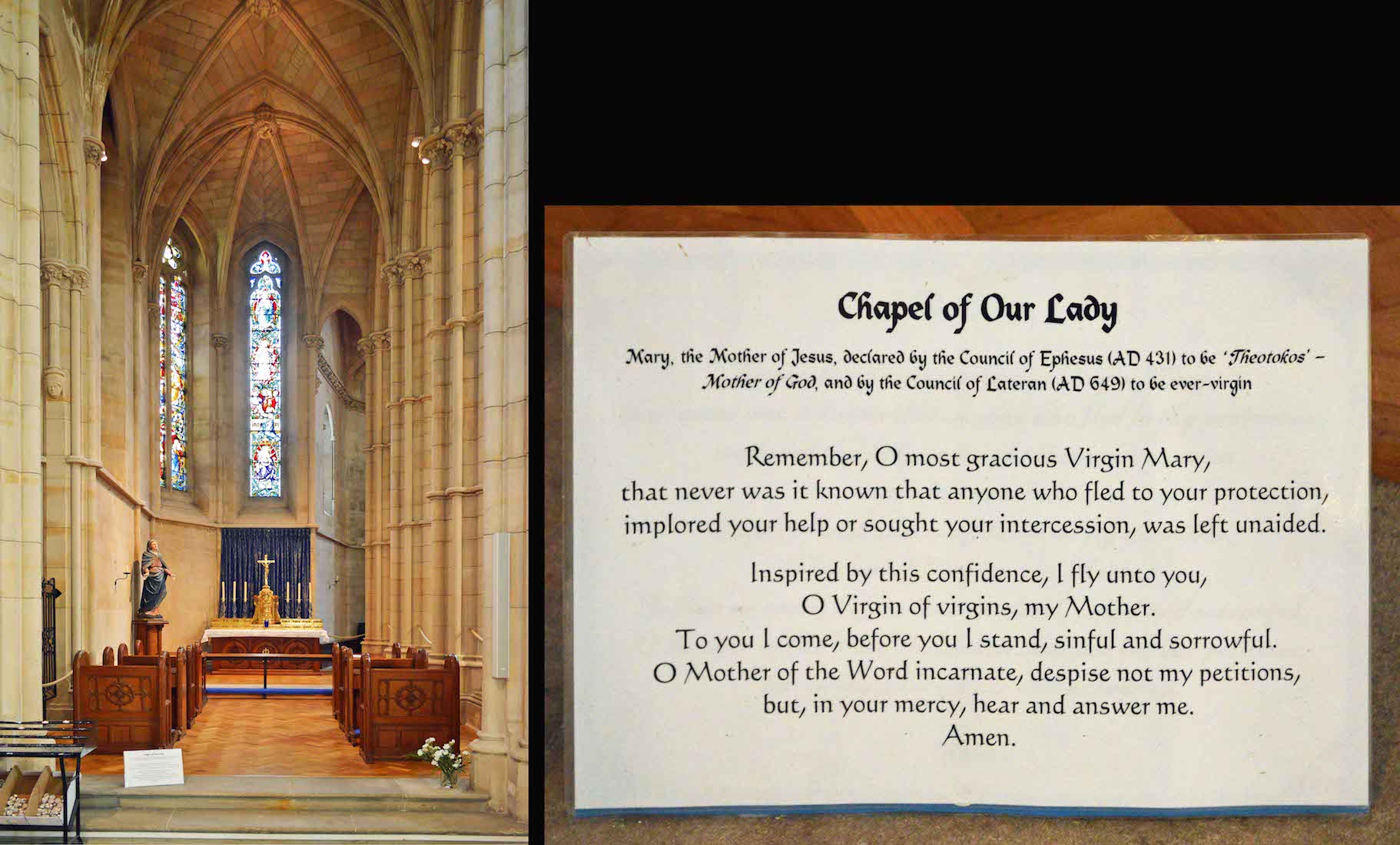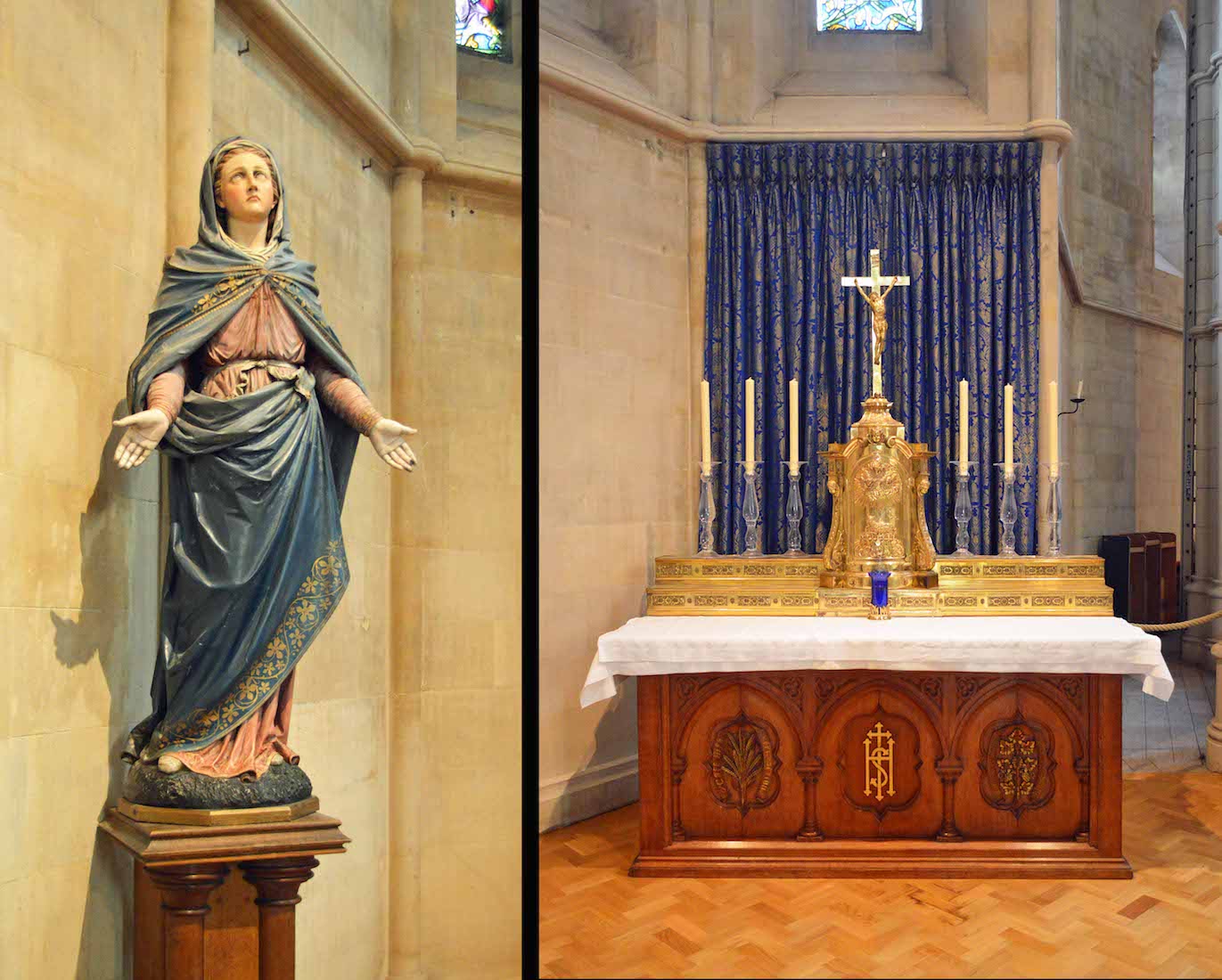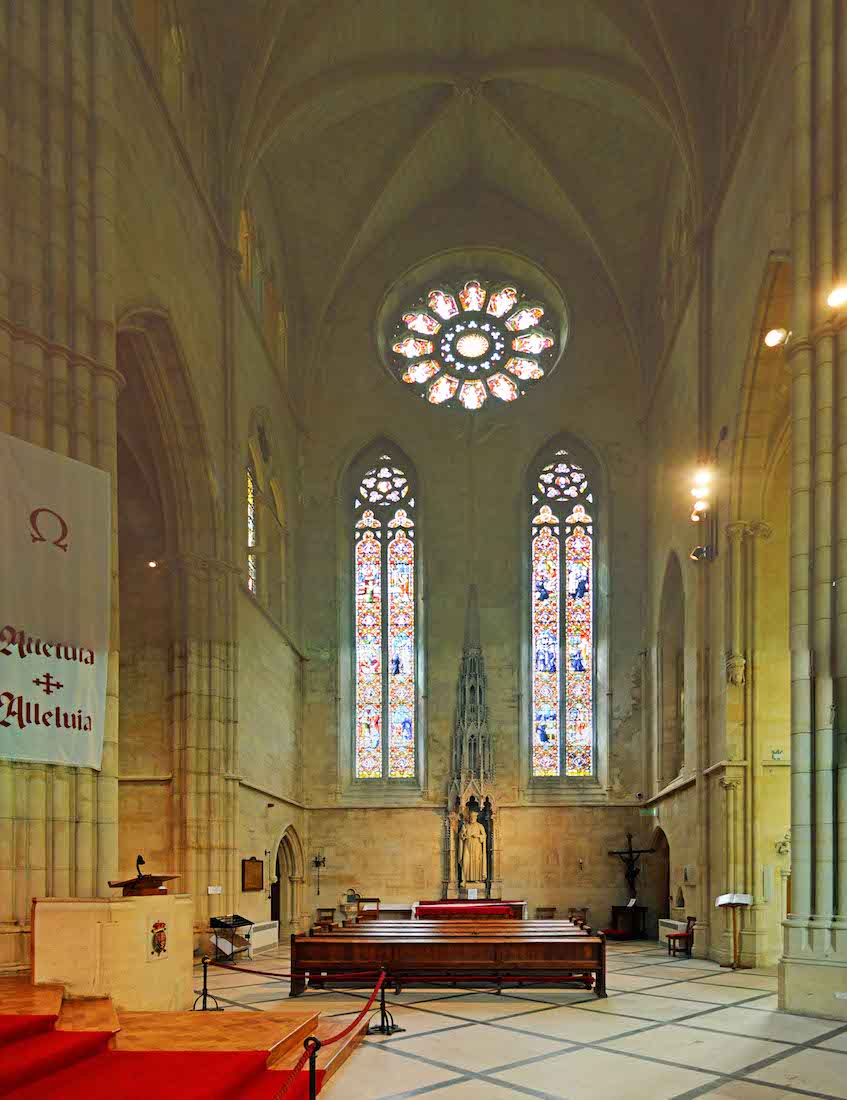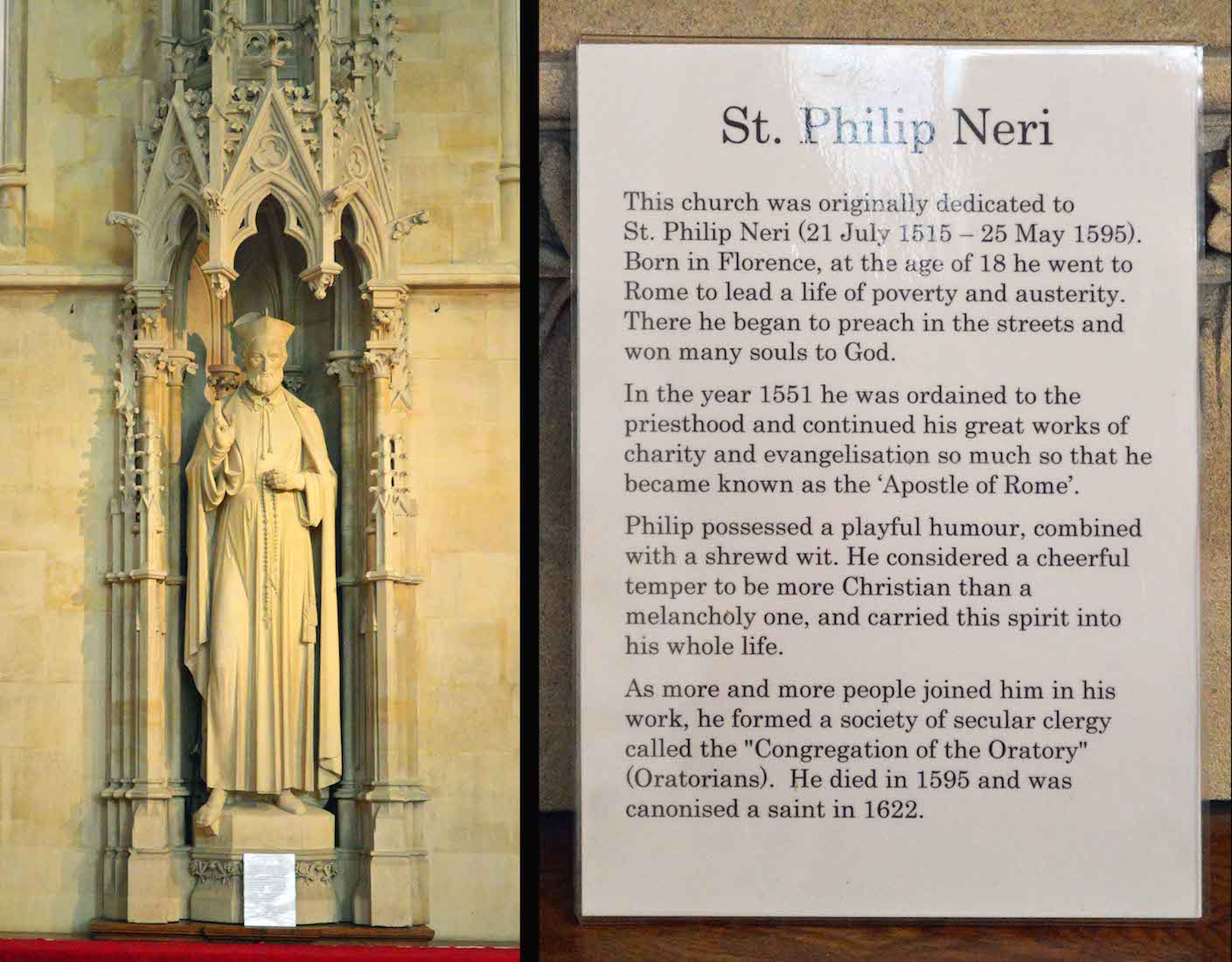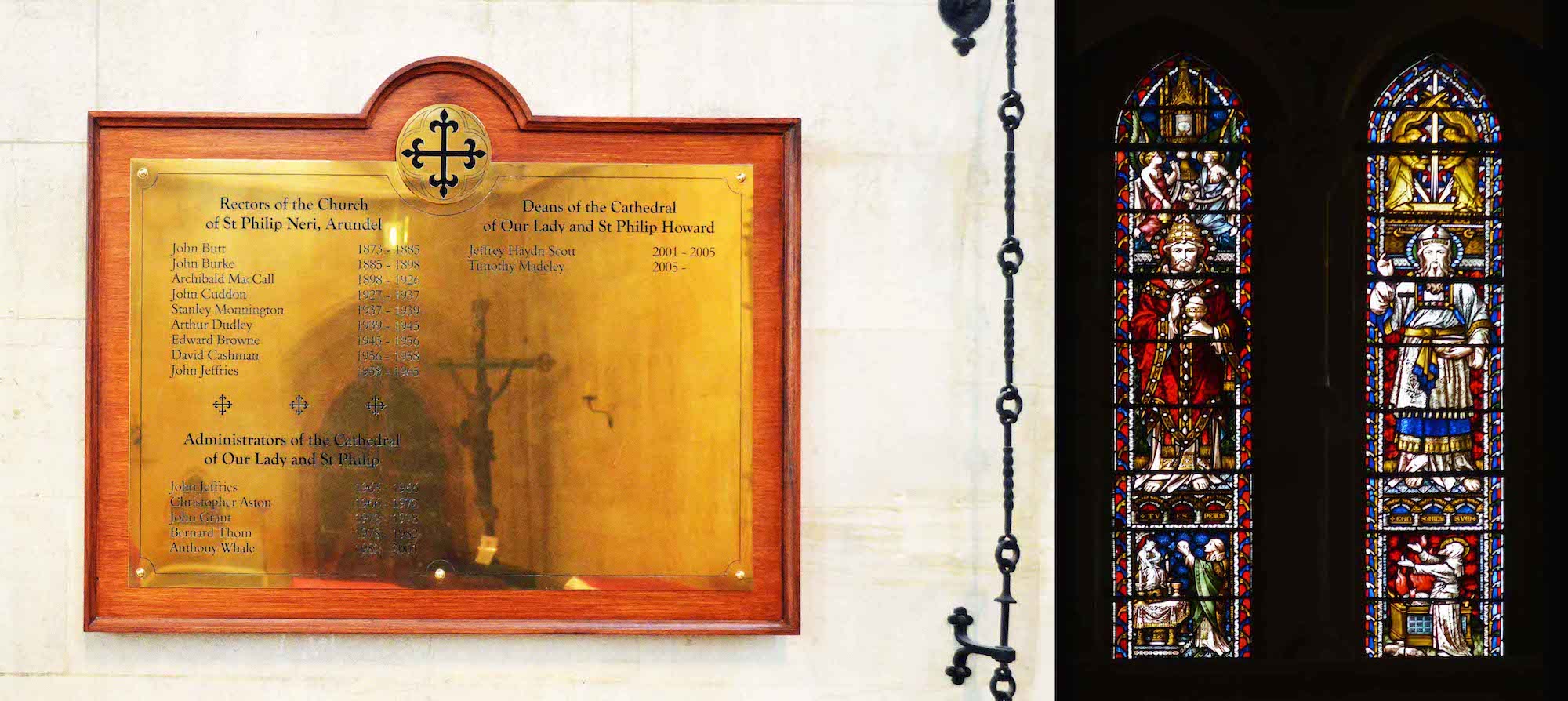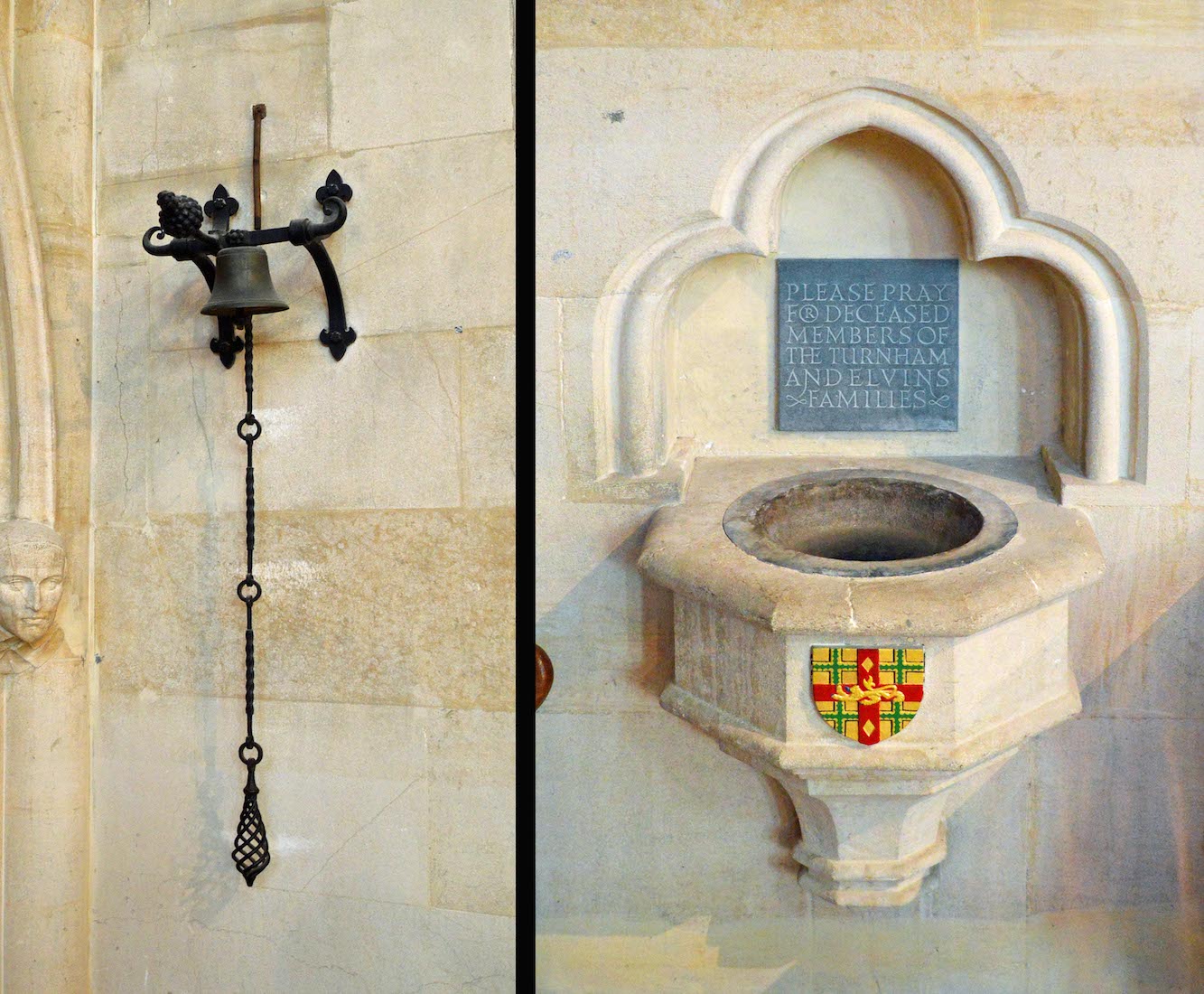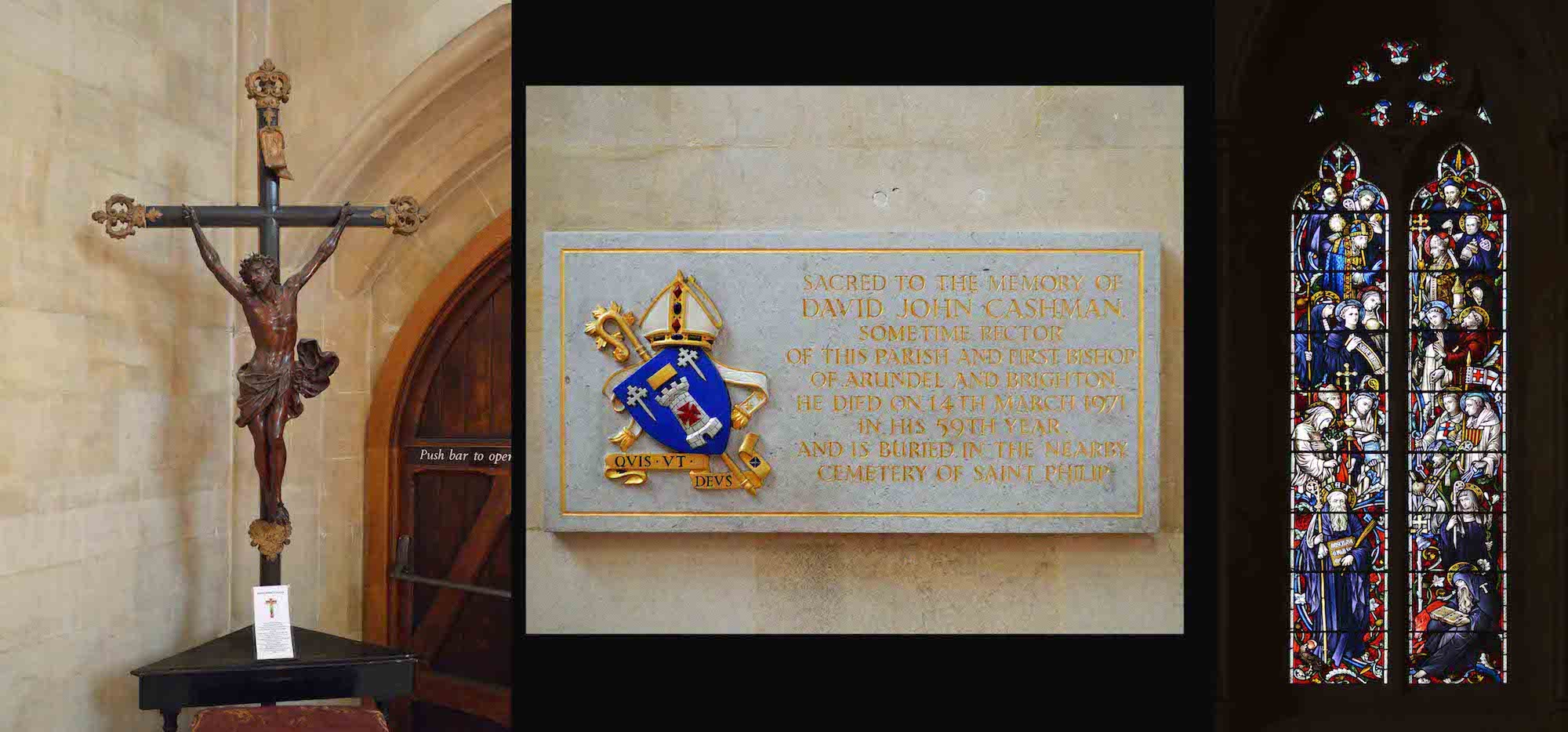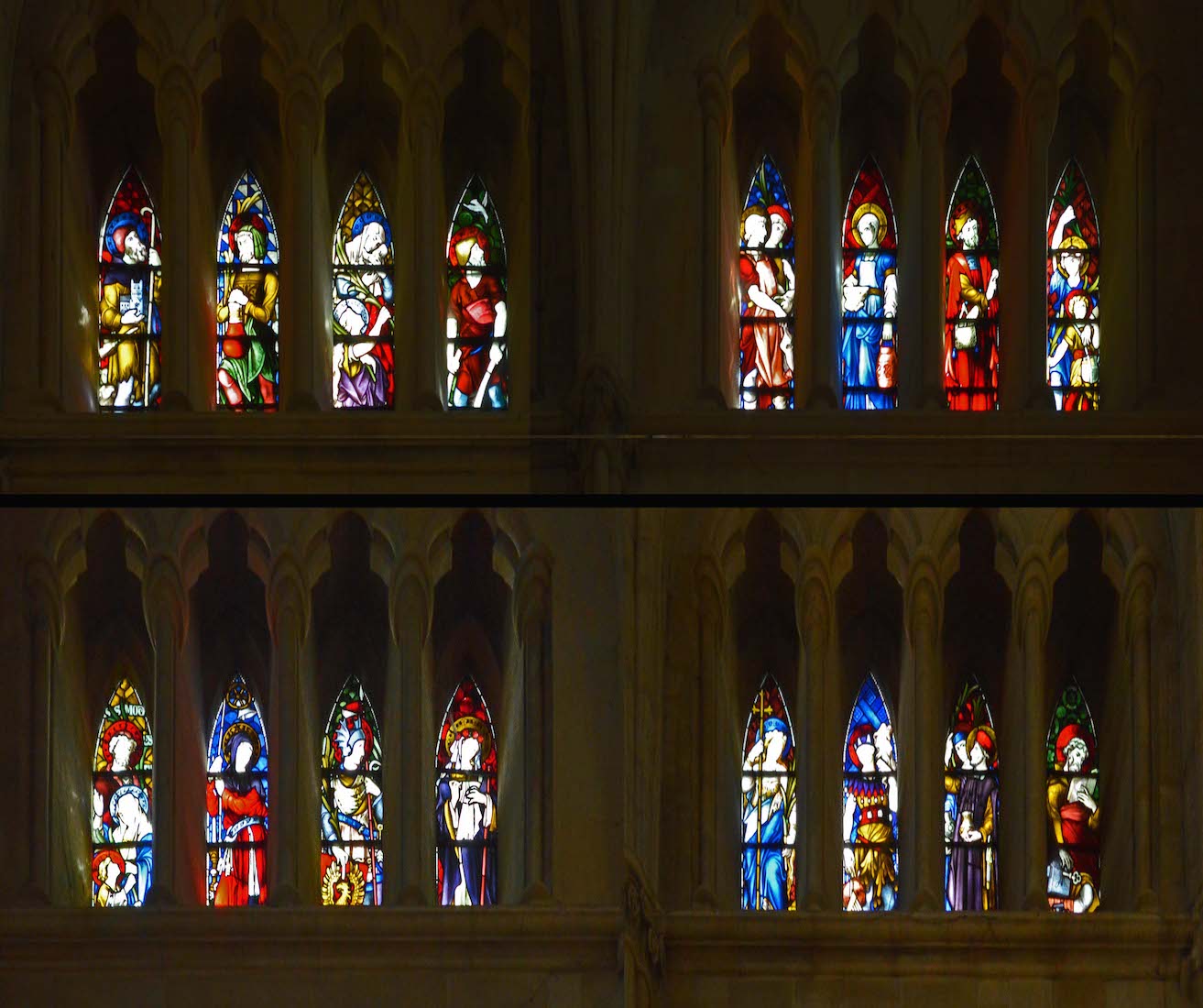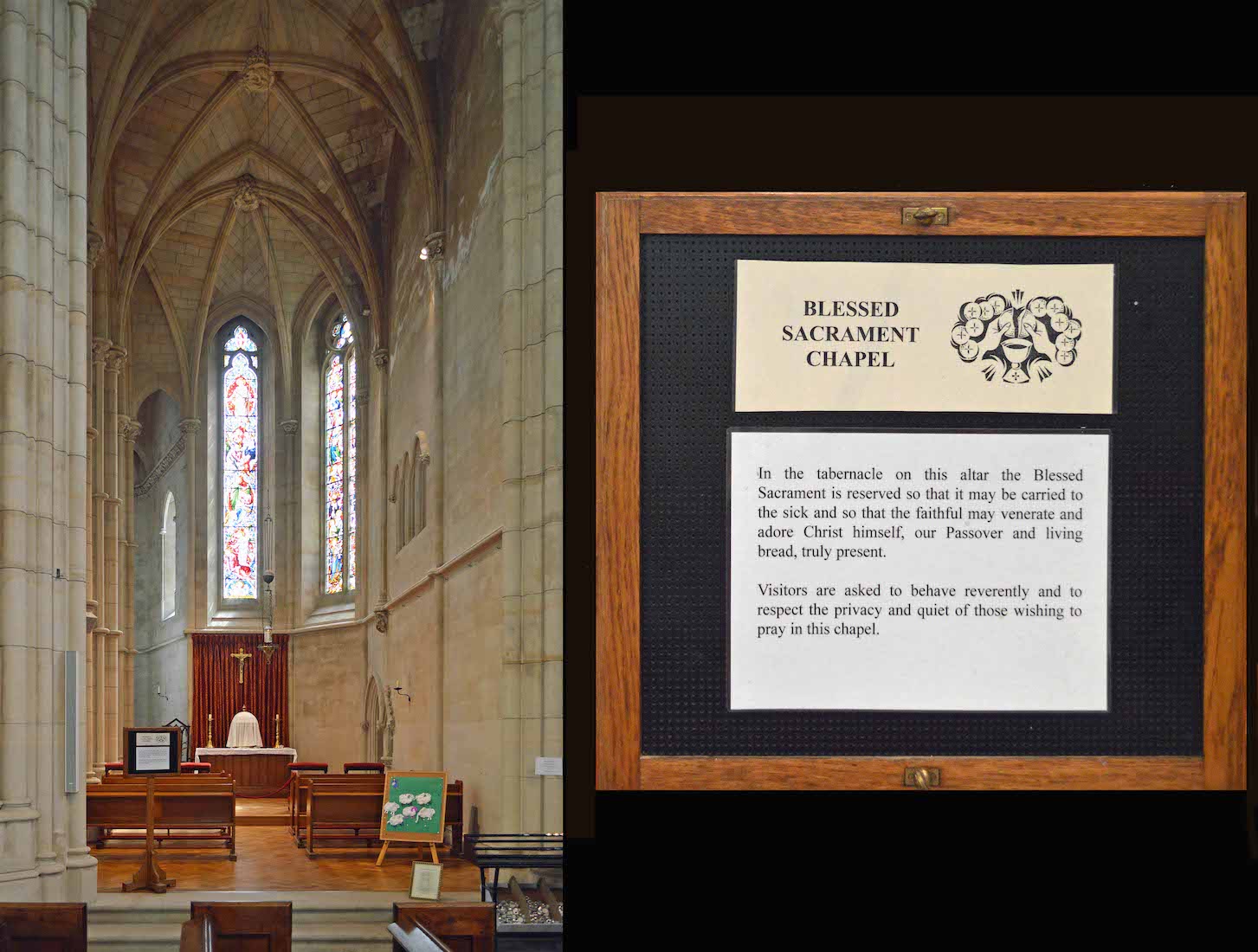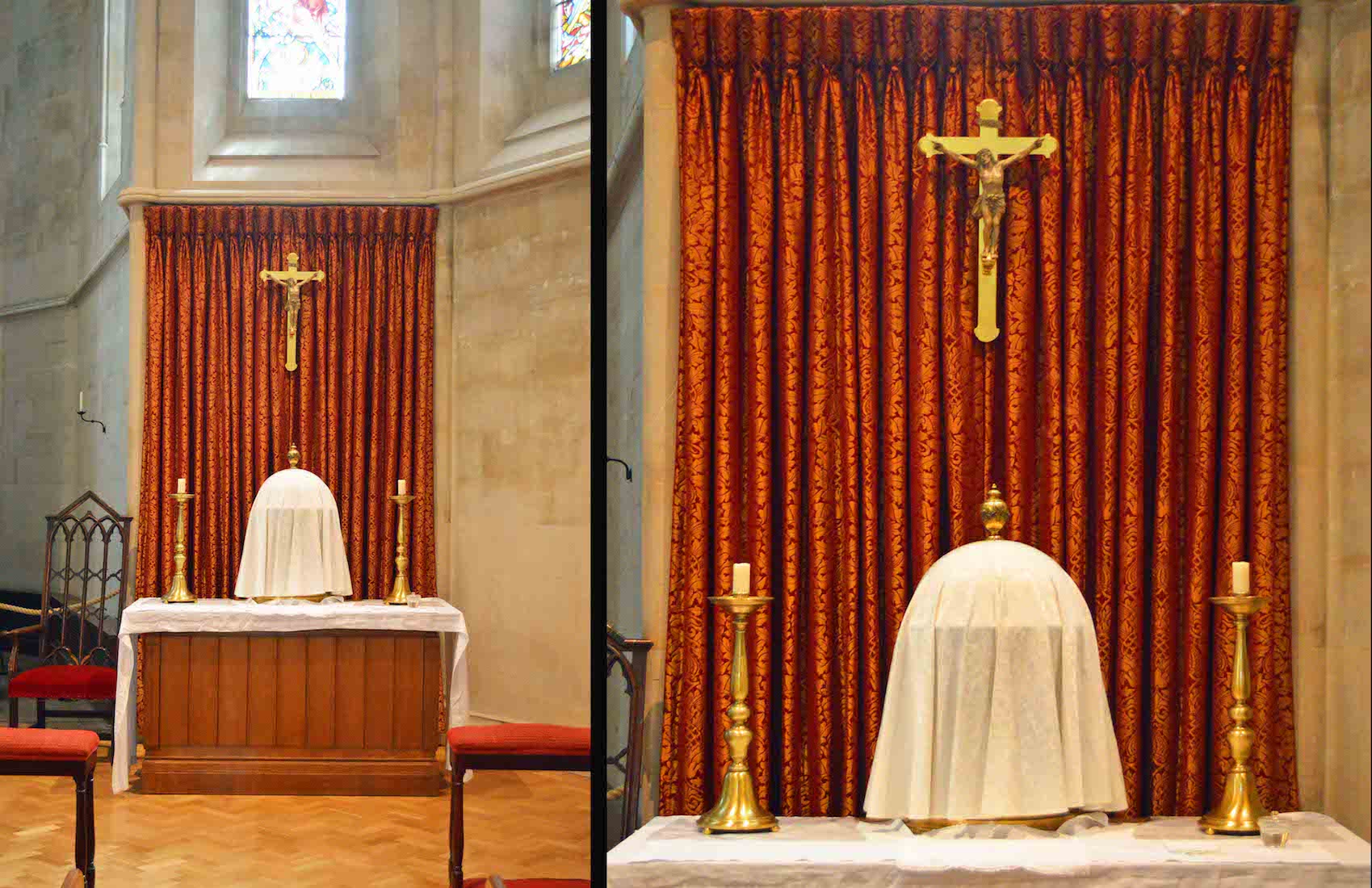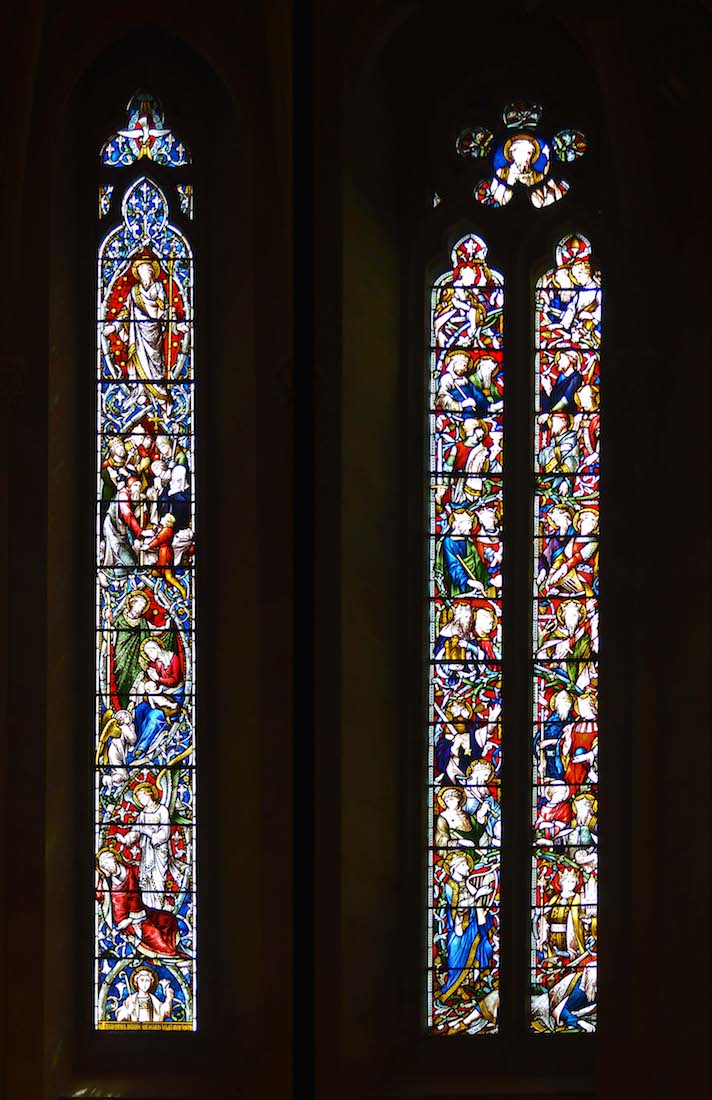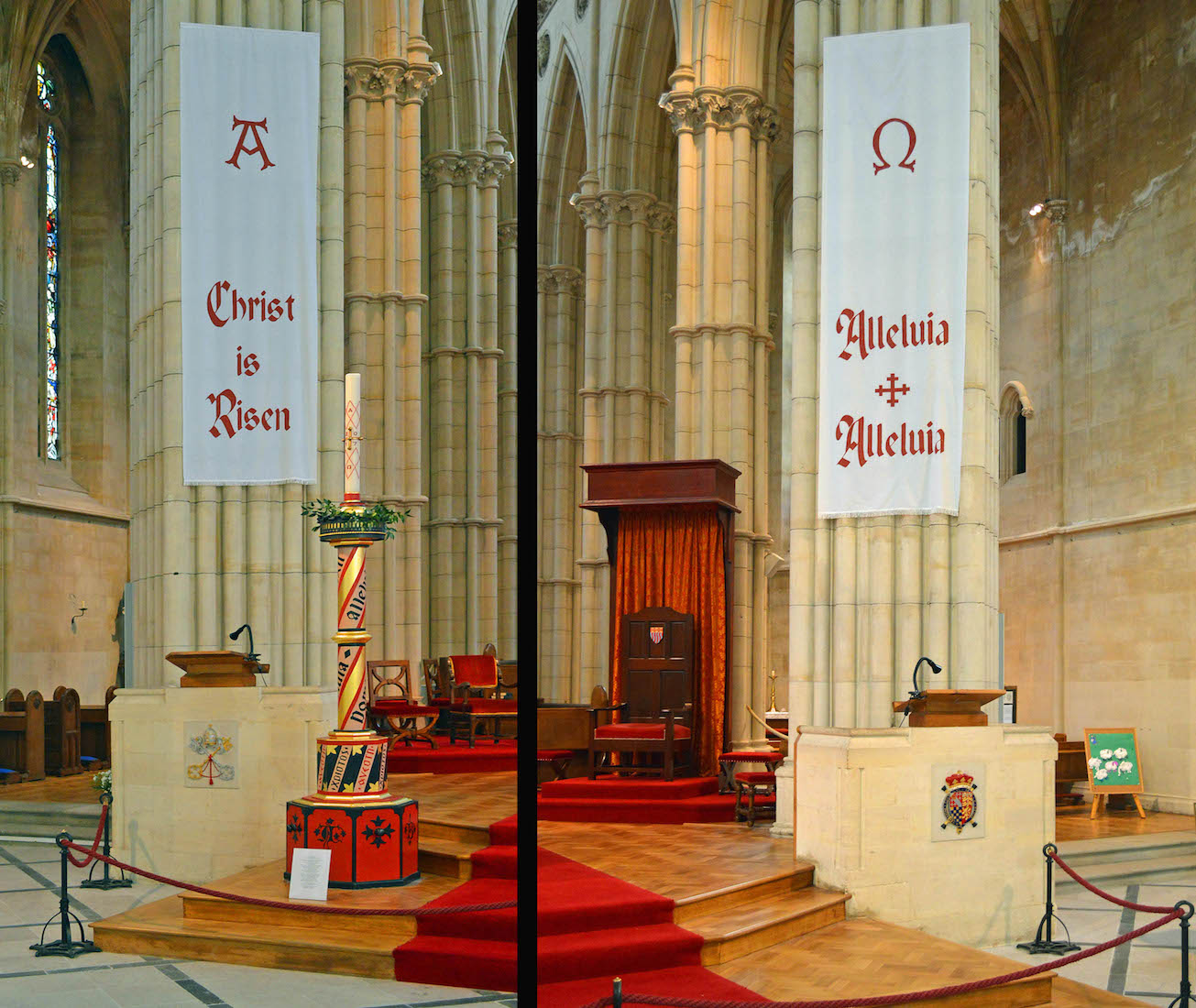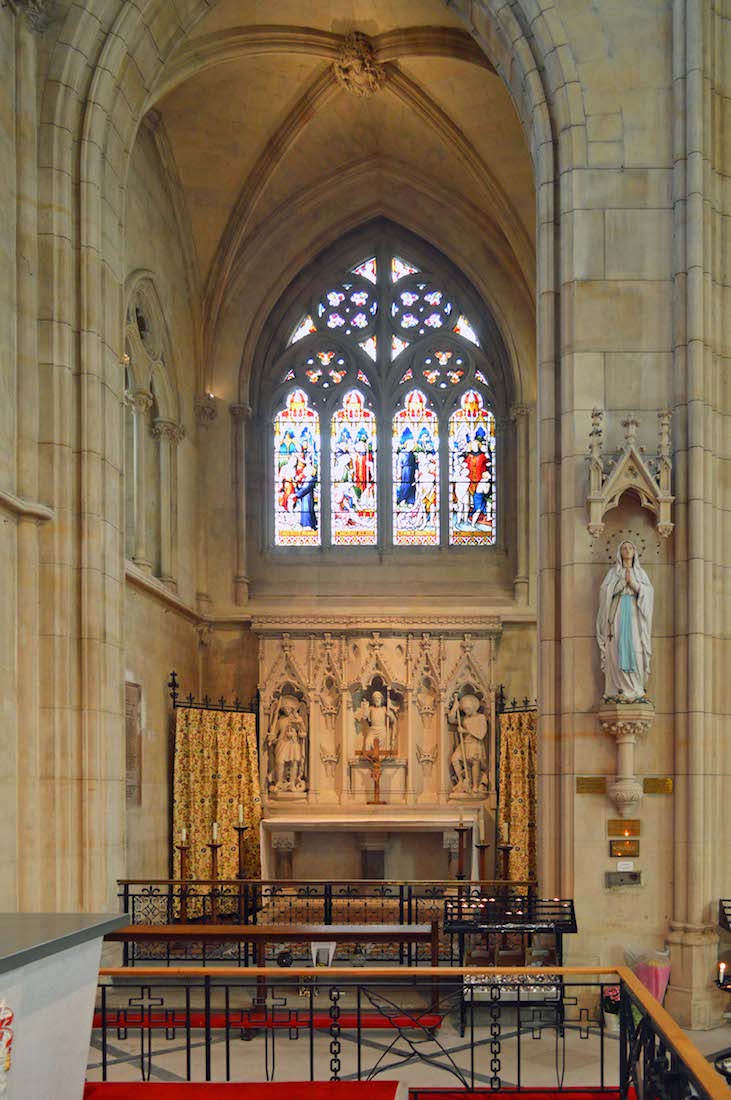
St WIlfrid’s Chapel is a small chapel with altar, reredos, and two stained glass windows – the large visible window, and a smaller window on the North wall to the left. St Wilfrid (634 – 709) was Bishop of York and a great defender of the papal authority, who did much to bring the Celtic Church closer to Rome. PLAN
42. CHAPEL REREDOS

The sculpted reredos of the altar represents Christ rising from the tomb with the Archangel Michael and St George, both patrons of soldiers. This chapel also serves as a War Memorial chapel. There is a plaque to men of Arundel who fell in both world wars.
43. ST WILFRID’S CHAPEL WINDOWS
The window in the North wall, left of the altar, represents Wilfrid seated in his bishop’s chair. The window above the altar tells of Wilfrid’s missionary work in Sussex. The left light shows the Christian king of Sussex, Edilwalch, welcoming Wilfrid. Then successively we see Wilfrid preaching, teaching fishing skills to the Sussex men, and baptizing.
44. ST WILFRID’S CHAPEL TILING
This fancy tiling pattern lines the front edge of the platform of the chapel. Cathedrals often have interesting and ornate tiling patterns.
45. LADY CHAPEL
Next to St Wilfrid’s Chapel is the Lady Chapel. This is a somewhat larger chapel, but simply furnished. There are stained glass windows, a statue, and an altar with tabernacle and candles. The colouring of the chapel is overall blue, with blue recognized as the colour of purity. An ambulatory passage leads off to the far right, passing under the apse windows, but there is no public access to this.
46. STATUE AND ALTAR
The statue is of Mary, Our Lady of Sorrows. This is a not uncommon title: ‘The Seven Sorrows of Mary’ is a popular Roman Catholic devotion, but the statue is unusual. The tabernacle is believed to be the first English tabernacle made after the Reformation. It was discovered in a lumber room in 1976, and narrowly missed being disposed of. Inside was found an original parchment with the words: ‘This Tabernacle was made by Chas. Kandler, Goldsmith at the Miter in St Martin’s Lane for his Grace Thos. Howard Duke of Norfolk Anno Dominie 1730’.
47. LADY CHAPEL WINDOWS
The pair of lights at left show (from the bottom): Mary as Queen of the Christians, Mary interceding for the faithful departed, and Mary Star of the Sea. The window at right shows (from the bottom): the Virgin of Sorrows, the Assumption, and the Coronation of Mary in Heaven. In fact there should be a third window photograph to the left of these two.
48. SOUTH TRANSEPT
This is largely another navigation window. At centre is the St Philip Neri altar with a statue of the saint under a lofty and delicate canopy, and above, three stained glass windows. There is a further stained glass window in each of the side walls. Other items of interest from left are: a brown list, a bell and a stoup, a crucifix, and a plaque on the West wall. The door by the bell leads through to the sacristy.
49. ST PHILIP NERI
Philip Romolo Neri (1515 – 1595), known as the Third Apostle of Rome, after Saints Peter and Paul, was an Italian priest noted for founding a society of secular clergy called the Congregation of the Oratory. Duke Henry was educated in the Oratory School in Birmingham. This and later influence of the Oratarians caused Duke Henry to partially dedicate this Church which he commissioned to St Philip Neri. Neri was canonised a saint in 1622.
50. SOUTH TRANSEPT SOUTH WINDOWS
The round wheel window represents the 12 fruits of the Holy Spirit. The two outer windows depict 12 scenes from the life of St Philip Neri. In groups of three from the bottom, left to right, we see: 1. Boy Philip at home, 2. Philip cares for poor pilgrims, 3. Philip encounters the Holy Spirit; 4. Philip with children of Rome, 5. Philip plans to go to India, 6. Philip receives the gift of patience; 7. Philip eats a frugal meal, 8. Philip greets young English priests, 9. Philip is offered a red hat; 10. Philip offers Mass, 11. Philip escapes temptation, 12. Philip’s holy death.
51. SOUTH TRANSEPT EAST WALL
The brass plaque gives an historic list of Rectors, Administrators and Deans of the Church/Cathedral. The window over the sacristy door has two lights representing the Mass, a sacrifice of the New Testament, and Old Testament sacrifice. So on the left is St Peter clothed in bishop’s vestments and wearing the triple crown of the popes, and on the right Aaron, high priest of the old Law.
52. BELL AND STOUP
At the right of the sacristy door is a small bell, used to indicate the beginning of a worship service. Next to this is a stoup for holding holy water. I have no information about the colourful shield.
53. SOUTH TRANSEPT WEST WALL
The stone plaque commemorates the Right Reverend David Cashman who was the first Bishop of Arundel and Brighton, and bears his arms. The window above shows the founders of the great religious orders. From the bottom, we see: (left) Benedict, Norbert, Robert of Molesme, Bruno, Philip Benizi, Juliana Falconieri, Bridget of Sweden, Alphonsus Liguori, Vincent de Paul, Ignatius Loyola; (right) Anthony of Egypt, Scholastica, Augustine of Hippo, Peter Nolasco and John of Matha, Francis, Dominic, Clare, Adalbert(?), Paul of the Cross, Philip Neri.
54. SOUTH TRANSEPT CLERESTORY WINDOWS
High above we find another set of interesting windows, on the East wall (top) and West wall (bottom). Difficult to photograph and hard to see!
55. BLESSED SACRAMENT CHAPEL
Off the Eastern side of the South transept is the (private) sacristy, and the Blessed Sacrament Chapel. We notice the stained glass windows and the altar bearing the tabernacle. Also on the far left is the ambulatory passage which we noticed before, leading to the Lady Chapel.
56. ALTAR AND TABERNACLE
As the notice reminds us, the tabernacle contains the reserved Elements of the Eucharist – bread (wafer) and wine which have been blessed, and are available to be taken to those who are sick. Two golden candlesticks and a gold crucifix complete the scene.
57. CHAPEL WINDOWS
The window at left features St Joseph. From the bottom: the shepherd boy Joseph, son of Jacob – prototype of Joseph of Nazareth, the angel appearing to Joseph, Joseph as guardian of the Holy Family, and at top, Joseph Protector of the Church. The adjacent two-light window is known as The Tree of Jesse, giving the ancestral line of Joseph beginning with Jesse and King David. The genealogy is given in Matthew’s gospel.
58. APSE AND SANCTUARY
Left and right are two ambos or pulpits. A Paschal candle stands at left, and the Bishop’s chair at right, a little to the rear. At centre is the stone altar with the high altar behind. In the background are stained glass windows and the hanging rood Cross. Below the clerestory windows are 22 roundels. Those on the North (left) represent the holy men of the Old Testament – patriarchs, priests and prophets. Those on the South side are roundels of popes, martyrs and confessors of the Christian church. Unfortunately this area is not accessible to the public.
59. AMBOS, PASCHAL CANDLE AND CATHEDRA
The Paschal candle is a common feature of cathedrals and churches. It represents Christ as the Light of the World, and features prominently during the Easter period. The ambo serves the purpose of pulpit and lectern. It is unusual for a cathedral to have two ambos. The cathedra is seen to the rear of the right view.
60. COATS OF ARMS
Each of the pulpits is made of Bath stone and features a coat of arms. The gospel side (North) is emblazoned with the papal insignia, and the epistle side (South) with the arms of the Earl Marshall, an office held by the Duke of Norfolk..


